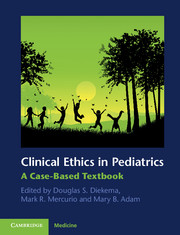Book contents
- Frontmatter
- Contents
- Contributors
- Preface
- Section 1 Core issues in clinical pediatric ethics
- Pediatric decision-making: informed consent, parental permission, and child assent
- 2 Pediatric decision-making: adolescent patients
- 3 Parental refusals of recommended medical interventions
- 4 Adolescent confidentiality
- 5 Refusals of treatment in adolescents and young adults
- 6 Family beliefs and the medical care of children
- 7 Fidelity and truthfulness in the pediatric setting: withholding information from children and adolescents
- 8 Fidelity and truthfulness: disclosure of errors
- 9 Requests for “non-therapeutic” interventions in children: male circumcision
- Section 2 Ethical issues at the beginning of life: perinatology and neonatology
- Section 3 When a child dies: ethical issues at the end of life
- Section 4 Ethical issues posed by advances in medical technology and science
- Section 5 Children, public health, and justice
- Section 6 Special topics in pediatric ethics
- Index
- References
8 - Fidelity and truthfulness: disclosure of errors
from Section 1 - Core issues in clinical pediatric ethics
Published online by Cambridge University Press: 07 October 2011
- Frontmatter
- Contents
- Contributors
- Preface
- Section 1 Core issues in clinical pediatric ethics
- Pediatric decision-making: informed consent, parental permission, and child assent
- 2 Pediatric decision-making: adolescent patients
- 3 Parental refusals of recommended medical interventions
- 4 Adolescent confidentiality
- 5 Refusals of treatment in adolescents and young adults
- 6 Family beliefs and the medical care of children
- 7 Fidelity and truthfulness in the pediatric setting: withholding information from children and adolescents
- 8 Fidelity and truthfulness: disclosure of errors
- 9 Requests for “non-therapeutic” interventions in children: male circumcision
- Section 2 Ethical issues at the beginning of life: perinatology and neonatology
- Section 3 When a child dies: ethical issues at the end of life
- Section 4 Ethical issues posed by advances in medical technology and science
- Section 5 Children, public health, and justice
- Section 6 Special topics in pediatric ethics
- Index
- References
Summary
Case narrative: medical misadventure and the case of Chloe
Chloe is a 3-month-old infant who was brought to the emergency department by her parents after developing a fever. Over the past 18 hours, she has become increasingly fussy and refused to nurse. While Chloe was being weighed in the triage room, her parents inquired about her weight in pounds, a number quickly provided by flicking a switch on the scale that changed the reading from metric (5.4 kilograms) to English (12 pounds) units. The nursing team was about to change shift and a nurse who was recording the weight heard Chloe’s weight as 12 pounds and recorded this number on the triage chart. This weight was then entered as the kilogram dose calculation weight in Chloe’s electronic medical record by a medical technician. During her evaluation, Chloe appeared ill, and displayed signs of moderate dehydration. Her laboratory findings were consistent with a urinary tract infection and she was admitted for intravenous antibiotic treatment with ampicillin and gentamicin; these drugs were ordered via the computerized provider order entry system, the doses calculated based on the infant’s recorded weight. During the order entry, several message boxes appeared on the computer screen providing hospital announcements. Additionally, a warning box appeared questioning the doses of both antibiotics as excessive given the age of the patient. The provider in the emergency department, who had been on-duty for 14 hours at that point, was distracted and clicked all the dialogue boxes closed, permitting the order to be signed. The ampicillin was infused while Chloe was in the emergency department; the gentamicin dose arrived at her bedside just before she was transported to her acute care inpatient room. The emergency department nurse connected the gentamicin syringe to Chloe’s IV pump, and the acute care nurse activated the pump upon arrival at Chloe’s room. Over the next 12 hours, Chloe’s urine output did not normalize despite appropriate fluid resuscitation efforts. While evaluating her low urine output, she was weighed again and this new weight was recorded in her nursing notes. During change of nursing shift, Chloe’s nurse reviewed her charting notes and recognized that the weight being used for the medications was over twice the correct weight and realized that the two antibiotics were overdosed. Chloe’s nurse then called the on-call hospitalist to report the two medication errors. Because gentamicin can cause kidney and hearing damage, the level of Chloe’s gentamicin level was checked and was found to be markedly elevated at 25 mcg/ml. Her serum creatinine had increased from 0.8 on admission to 3.5 mg/dl, suggestive of rapidly worsening kidney function.
- Type
- Chapter
- Information
- Clinical Ethics in PediatricsA Case-Based Textbook, pp. 37 - 42Publisher: Cambridge University PressPrint publication year: 2011
References
- 1
- Cited by



